Forces Driving and Resisting Change in Organizations
VerifiedAdded on 2020/06/04
|13
|3885
|483
AI Summary
Organizations constantly face changes driven by various internal and external factors. Driving forces are those that push the organization towards change, such as technological advancements, market demands, or regulatory requirements. Conversely, resisting forces hinder this progress, often due to organizational inertia, cultural resistance, or lack of resources. Understanding these dynamics is crucial for effective change management. Leaders can leverage force field analysis to identify and strengthen driving forces while minimizing resistance. This strategic approach not only facilitates smoother transitions but also enhances overall organizational agility and competitiveness.
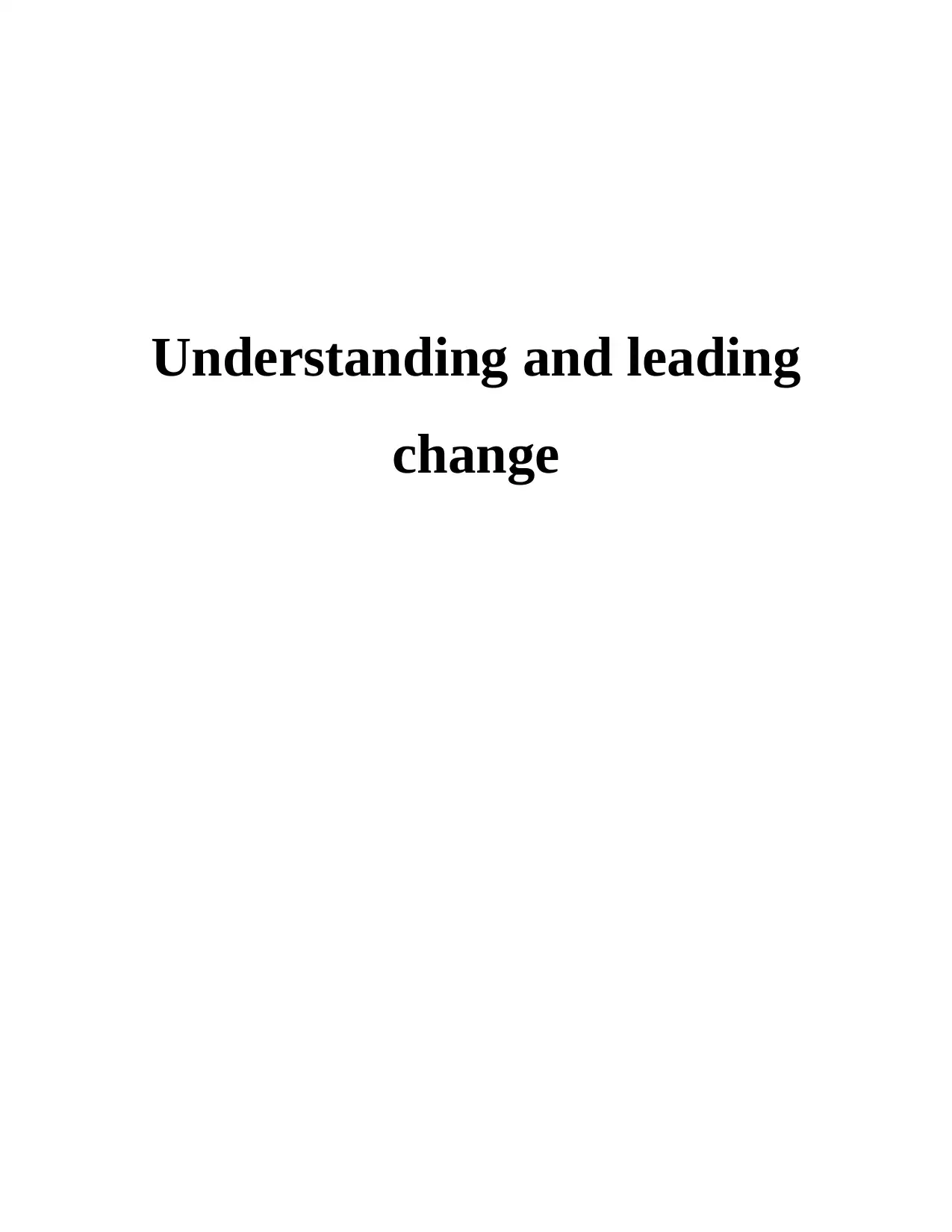
Understanding and leading
change
change
Paraphrase This Document
Need a fresh take? Get an instant paraphrase of this document with our AI Paraphraser
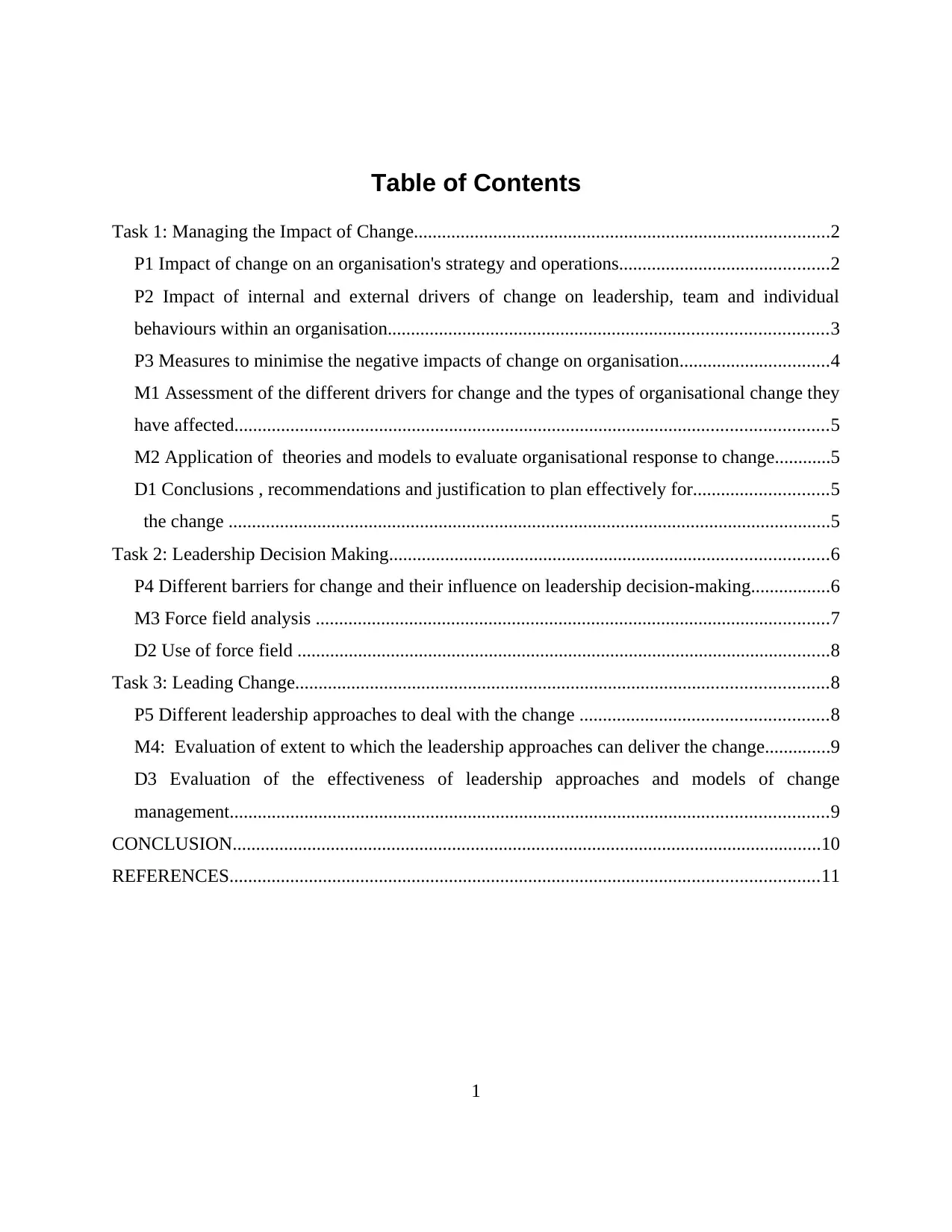
Table of Contents
Task 1: Managing the Impact of Change.........................................................................................2
P1 Impact of change on an organisation's strategy and operations.............................................2
P2 Impact of internal and external drivers of change on leadership, team and individual
behaviours within an organisation..............................................................................................3
P3 Measures to minimise the negative impacts of change on organisation................................4
M1 Assessment of the different drivers for change and the types of organisational change they
have affected...............................................................................................................................5
M2 Application of theories and models to evaluate organisational response to change............5
D1 Conclusions , recommendations and justification to plan effectively for.............................5
the change .................................................................................................................................5
Task 2: Leadership Decision Making..............................................................................................6
P4 Different barriers for change and their influence on leadership decision-making.................6
M3 Force field analysis ..............................................................................................................7
D2 Use of force field ..................................................................................................................8
Task 3: Leading Change..................................................................................................................8
P5 Different leadership approaches to deal with the change .....................................................8
M4: Evaluation of extent to which the leadership approaches can deliver the change..............9
D3 Evaluation of the effectiveness of leadership approaches and models of change
management................................................................................................................................9
CONCLUSION..............................................................................................................................10
REFERENCES..............................................................................................................................11
1
Task 1: Managing the Impact of Change.........................................................................................2
P1 Impact of change on an organisation's strategy and operations.............................................2
P2 Impact of internal and external drivers of change on leadership, team and individual
behaviours within an organisation..............................................................................................3
P3 Measures to minimise the negative impacts of change on organisation................................4
M1 Assessment of the different drivers for change and the types of organisational change they
have affected...............................................................................................................................5
M2 Application of theories and models to evaluate organisational response to change............5
D1 Conclusions , recommendations and justification to plan effectively for.............................5
the change .................................................................................................................................5
Task 2: Leadership Decision Making..............................................................................................6
P4 Different barriers for change and their influence on leadership decision-making.................6
M3 Force field analysis ..............................................................................................................7
D2 Use of force field ..................................................................................................................8
Task 3: Leading Change..................................................................................................................8
P5 Different leadership approaches to deal with the change .....................................................8
M4: Evaluation of extent to which the leadership approaches can deliver the change..............9
D3 Evaluation of the effectiveness of leadership approaches and models of change
management................................................................................................................................9
CONCLUSION..............................................................................................................................10
REFERENCES..............................................................................................................................11
1
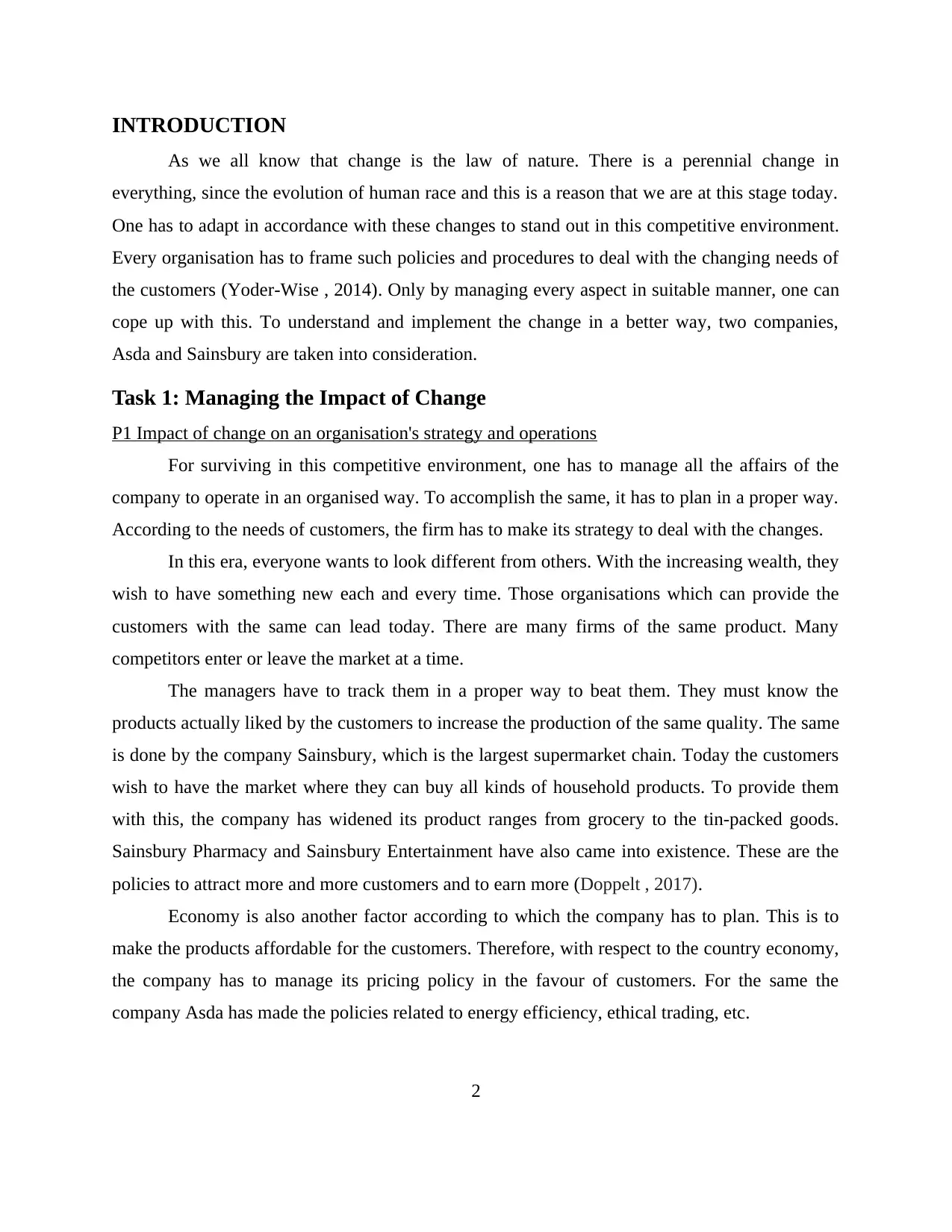
INTRODUCTION
As we all know that change is the law of nature. There is a perennial change in
everything, since the evolution of human race and this is a reason that we are at this stage today.
One has to adapt in accordance with these changes to stand out in this competitive environment.
Every organisation has to frame such policies and procedures to deal with the changing needs of
the customers (Yoder-Wise , 2014). Only by managing every aspect in suitable manner, one can
cope up with this. To understand and implement the change in a better way, two companies,
Asda and Sainsbury are taken into consideration.
Task 1: Managing the Impact of Change
P1 Impact of change on an organisation's strategy and operations
For surviving in this competitive environment, one has to manage all the affairs of the
company to operate in an organised way. To accomplish the same, it has to plan in a proper way.
According to the needs of customers, the firm has to make its strategy to deal with the changes.
In this era, everyone wants to look different from others. With the increasing wealth, they
wish to have something new each and every time. Those organisations which can provide the
customers with the same can lead today. There are many firms of the same product. Many
competitors enter or leave the market at a time.
The managers have to track them in a proper way to beat them. They must know the
products actually liked by the customers to increase the production of the same quality. The same
is done by the company Sainsbury, which is the largest supermarket chain. Today the customers
wish to have the market where they can buy all kinds of household products. To provide them
with this, the company has widened its product ranges from grocery to the tin-packed goods.
Sainsbury Pharmacy and Sainsbury Entertainment have also came into existence. These are the
policies to attract more and more customers and to earn more (Doppelt , 2017).
Economy is also another factor according to which the company has to plan. This is to
make the products affordable for the customers. Therefore, with respect to the country economy,
the company has to manage its pricing policy in the favour of customers. For the same the
company Asda has made the policies related to energy efficiency, ethical trading, etc.
2
As we all know that change is the law of nature. There is a perennial change in
everything, since the evolution of human race and this is a reason that we are at this stage today.
One has to adapt in accordance with these changes to stand out in this competitive environment.
Every organisation has to frame such policies and procedures to deal with the changing needs of
the customers (Yoder-Wise , 2014). Only by managing every aspect in suitable manner, one can
cope up with this. To understand and implement the change in a better way, two companies,
Asda and Sainsbury are taken into consideration.
Task 1: Managing the Impact of Change
P1 Impact of change on an organisation's strategy and operations
For surviving in this competitive environment, one has to manage all the affairs of the
company to operate in an organised way. To accomplish the same, it has to plan in a proper way.
According to the needs of customers, the firm has to make its strategy to deal with the changes.
In this era, everyone wants to look different from others. With the increasing wealth, they
wish to have something new each and every time. Those organisations which can provide the
customers with the same can lead today. There are many firms of the same product. Many
competitors enter or leave the market at a time.
The managers have to track them in a proper way to beat them. They must know the
products actually liked by the customers to increase the production of the same quality. The same
is done by the company Sainsbury, which is the largest supermarket chain. Today the customers
wish to have the market where they can buy all kinds of household products. To provide them
with this, the company has widened its product ranges from grocery to the tin-packed goods.
Sainsbury Pharmacy and Sainsbury Entertainment have also came into existence. These are the
policies to attract more and more customers and to earn more (Doppelt , 2017).
Economy is also another factor according to which the company has to plan. This is to
make the products affordable for the customers. Therefore, with respect to the country economy,
the company has to manage its pricing policy in the favour of customers. For the same the
company Asda has made the policies related to energy efficiency, ethical trading, etc.
2
⊘ This is a preview!⊘
Do you want full access?
Subscribe today to unlock all pages.

Trusted by 1+ million students worldwide
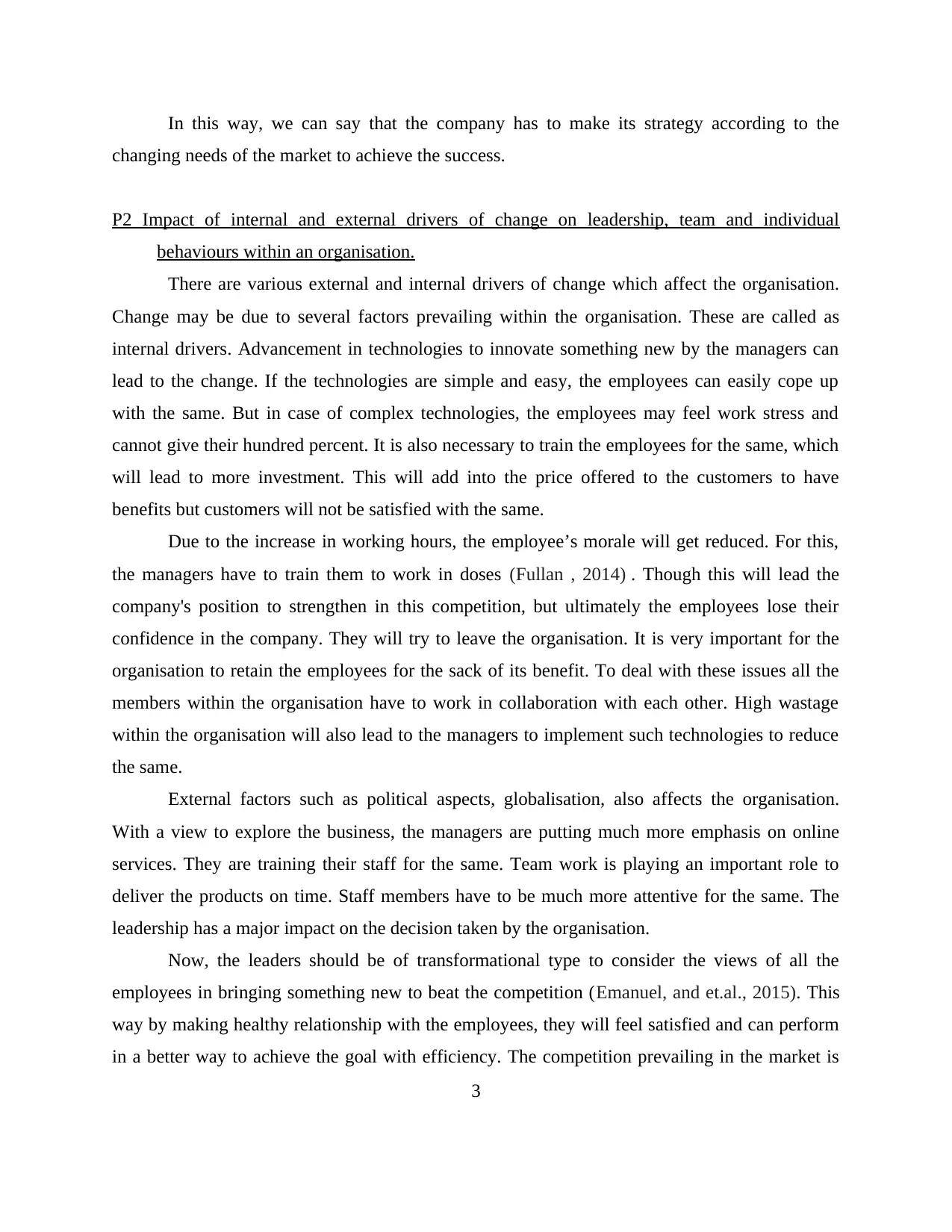
In this way, we can say that the company has to make its strategy according to the
changing needs of the market to achieve the success.
P2 Impact of internal and external drivers of change on leadership, team and individual
behaviours within an organisation.
There are various external and internal drivers of change which affect the organisation.
Change may be due to several factors prevailing within the organisation. These are called as
internal drivers. Advancement in technologies to innovate something new by the managers can
lead to the change. If the technologies are simple and easy, the employees can easily cope up
with the same. But in case of complex technologies, the employees may feel work stress and
cannot give their hundred percent. It is also necessary to train the employees for the same, which
will lead to more investment. This will add into the price offered to the customers to have
benefits but customers will not be satisfied with the same.
Due to the increase in working hours, the employee’s morale will get reduced. For this,
the managers have to train them to work in doses (Fullan , 2014) . Though this will lead the
company's position to strengthen in this competition, but ultimately the employees lose their
confidence in the company. They will try to leave the organisation. It is very important for the
organisation to retain the employees for the sack of its benefit. To deal with these issues all the
members within the organisation have to work in collaboration with each other. High wastage
within the organisation will also lead to the managers to implement such technologies to reduce
the same.
External factors such as political aspects, globalisation, also affects the organisation.
With a view to explore the business, the managers are putting much more emphasis on online
services. They are training their staff for the same. Team work is playing an important role to
deliver the products on time. Staff members have to be much more attentive for the same. The
leadership has a major impact on the decision taken by the organisation.
Now, the leaders should be of transformational type to consider the views of all the
employees in bringing something new to beat the competition (Emanuel, and et.al., 2015). This
way by making healthy relationship with the employees, they will feel satisfied and can perform
in a better way to achieve the goal with efficiency. The competition prevailing in the market is
3
changing needs of the market to achieve the success.
P2 Impact of internal and external drivers of change on leadership, team and individual
behaviours within an organisation.
There are various external and internal drivers of change which affect the organisation.
Change may be due to several factors prevailing within the organisation. These are called as
internal drivers. Advancement in technologies to innovate something new by the managers can
lead to the change. If the technologies are simple and easy, the employees can easily cope up
with the same. But in case of complex technologies, the employees may feel work stress and
cannot give their hundred percent. It is also necessary to train the employees for the same, which
will lead to more investment. This will add into the price offered to the customers to have
benefits but customers will not be satisfied with the same.
Due to the increase in working hours, the employee’s morale will get reduced. For this,
the managers have to train them to work in doses (Fullan , 2014) . Though this will lead the
company's position to strengthen in this competition, but ultimately the employees lose their
confidence in the company. They will try to leave the organisation. It is very important for the
organisation to retain the employees for the sack of its benefit. To deal with these issues all the
members within the organisation have to work in collaboration with each other. High wastage
within the organisation will also lead to the managers to implement such technologies to reduce
the same.
External factors such as political aspects, globalisation, also affects the organisation.
With a view to explore the business, the managers are putting much more emphasis on online
services. They are training their staff for the same. Team work is playing an important role to
deliver the products on time. Staff members have to be much more attentive for the same. The
leadership has a major impact on the decision taken by the organisation.
Now, the leaders should be of transformational type to consider the views of all the
employees in bringing something new to beat the competition (Emanuel, and et.al., 2015). This
way by making healthy relationship with the employees, they will feel satisfied and can perform
in a better way to achieve the goal with efficiency. The competition prevailing in the market is
3
Paraphrase This Document
Need a fresh take? Get an instant paraphrase of this document with our AI Paraphraser
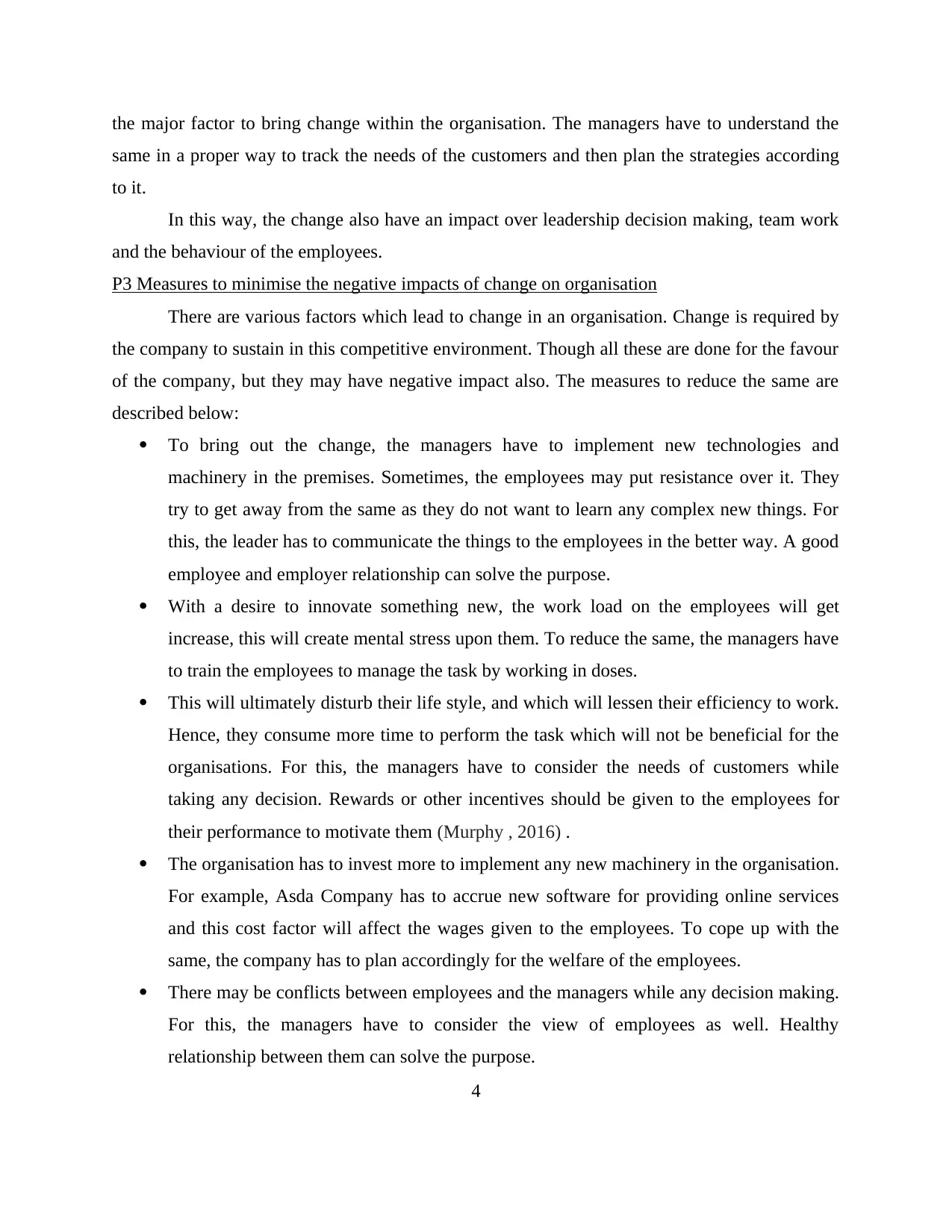
the major factor to bring change within the organisation. The managers have to understand the
same in a proper way to track the needs of the customers and then plan the strategies according
to it.
In this way, the change also have an impact over leadership decision making, team work
and the behaviour of the employees.
P3 Measures to minimise the negative impacts of change on organisation
There are various factors which lead to change in an organisation. Change is required by
the company to sustain in this competitive environment. Though all these are done for the favour
of the company, but they may have negative impact also. The measures to reduce the same are
described below:
To bring out the change, the managers have to implement new technologies and
machinery in the premises. Sometimes, the employees may put resistance over it. They
try to get away from the same as they do not want to learn any complex new things. For
this, the leader has to communicate the things to the employees in the better way. A good
employee and employer relationship can solve the purpose.
With a desire to innovate something new, the work load on the employees will get
increase, this will create mental stress upon them. To reduce the same, the managers have
to train the employees to manage the task by working in doses.
This will ultimately disturb their life style, and which will lessen their efficiency to work.
Hence, they consume more time to perform the task which will not be beneficial for the
organisations. For this, the managers have to consider the needs of customers while
taking any decision. Rewards or other incentives should be given to the employees for
their performance to motivate them (Murphy , 2016) .
The organisation has to invest more to implement any new machinery in the organisation.
For example, Asda Company has to accrue new software for providing online services
and this cost factor will affect the wages given to the employees. To cope up with the
same, the company has to plan accordingly for the welfare of the employees.
There may be conflicts between employees and the managers while any decision making.
For this, the managers have to consider the view of employees as well. Healthy
relationship between them can solve the purpose.
4
same in a proper way to track the needs of the customers and then plan the strategies according
to it.
In this way, the change also have an impact over leadership decision making, team work
and the behaviour of the employees.
P3 Measures to minimise the negative impacts of change on organisation
There are various factors which lead to change in an organisation. Change is required by
the company to sustain in this competitive environment. Though all these are done for the favour
of the company, but they may have negative impact also. The measures to reduce the same are
described below:
To bring out the change, the managers have to implement new technologies and
machinery in the premises. Sometimes, the employees may put resistance over it. They
try to get away from the same as they do not want to learn any complex new things. For
this, the leader has to communicate the things to the employees in the better way. A good
employee and employer relationship can solve the purpose.
With a desire to innovate something new, the work load on the employees will get
increase, this will create mental stress upon them. To reduce the same, the managers have
to train the employees to manage the task by working in doses.
This will ultimately disturb their life style, and which will lessen their efficiency to work.
Hence, they consume more time to perform the task which will not be beneficial for the
organisations. For this, the managers have to consider the needs of customers while
taking any decision. Rewards or other incentives should be given to the employees for
their performance to motivate them (Murphy , 2016) .
The organisation has to invest more to implement any new machinery in the organisation.
For example, Asda Company has to accrue new software for providing online services
and this cost factor will affect the wages given to the employees. To cope up with the
same, the company has to plan accordingly for the welfare of the employees.
There may be conflicts between employees and the managers while any decision making.
For this, the managers have to consider the view of employees as well. Healthy
relationship between them can solve the purpose.
4
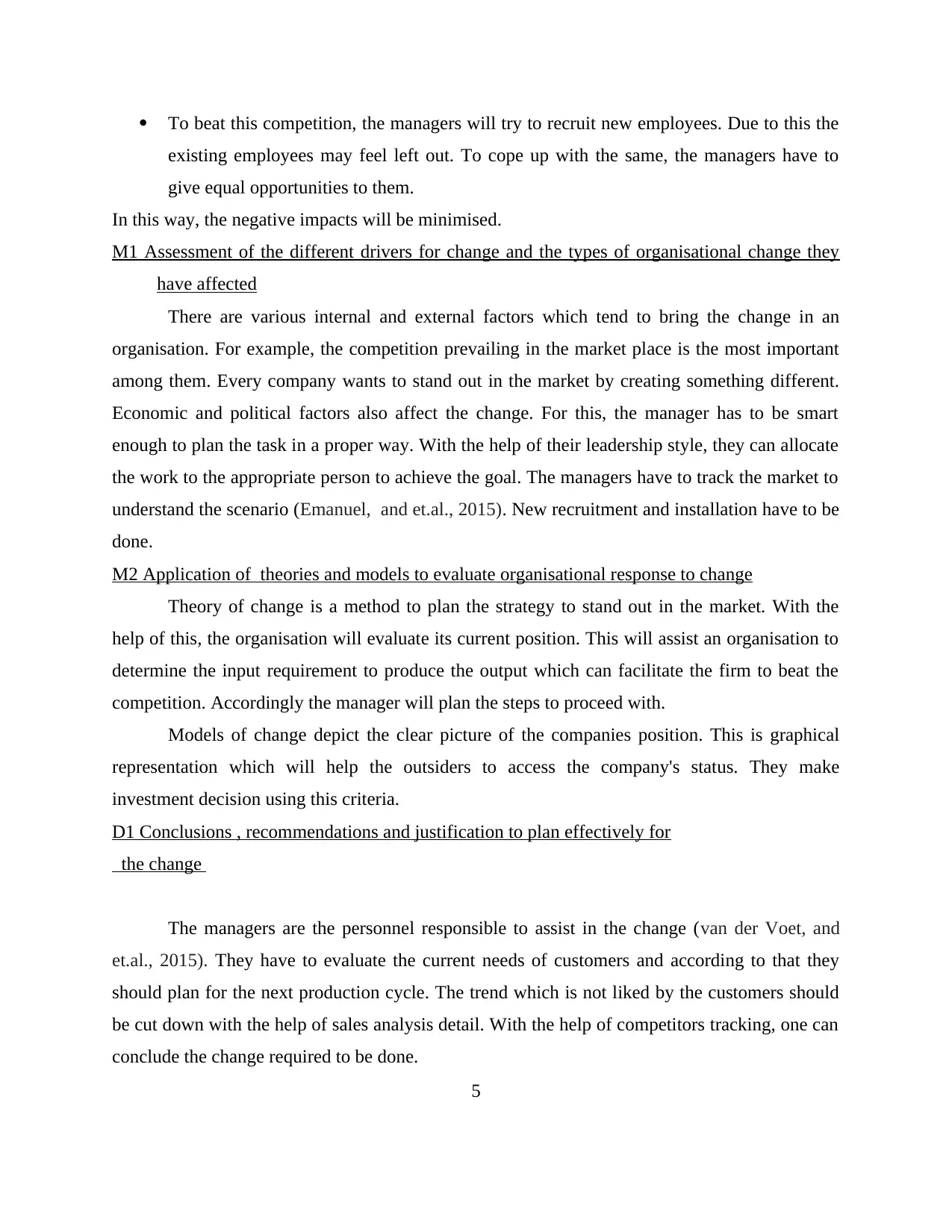
To beat this competition, the managers will try to recruit new employees. Due to this the
existing employees may feel left out. To cope up with the same, the managers have to
give equal opportunities to them.
In this way, the negative impacts will be minimised.
M1 Assessment of the different drivers for change and the types of organisational change they
have affected
There are various internal and external factors which tend to bring the change in an
organisation. For example, the competition prevailing in the market place is the most important
among them. Every company wants to stand out in the market by creating something different.
Economic and political factors also affect the change. For this, the manager has to be smart
enough to plan the task in a proper way. With the help of their leadership style, they can allocate
the work to the appropriate person to achieve the goal. The managers have to track the market to
understand the scenario (Emanuel, and et.al., 2015). New recruitment and installation have to be
done.
M2 Application of theories and models to evaluate organisational response to change
Theory of change is a method to plan the strategy to stand out in the market. With the
help of this, the organisation will evaluate its current position. This will assist an organisation to
determine the input requirement to produce the output which can facilitate the firm to beat the
competition. Accordingly the manager will plan the steps to proceed with.
Models of change depict the clear picture of the companies position. This is graphical
representation which will help the outsiders to access the company's status. They make
investment decision using this criteria.
D1 Conclusions , recommendations and justification to plan effectively for
the change
The managers are the personnel responsible to assist in the change (van der Voet, and
et.al., 2015). They have to evaluate the current needs of customers and according to that they
should plan for the next production cycle. The trend which is not liked by the customers should
be cut down with the help of sales analysis detail. With the help of competitors tracking, one can
conclude the change required to be done.
5
existing employees may feel left out. To cope up with the same, the managers have to
give equal opportunities to them.
In this way, the negative impacts will be minimised.
M1 Assessment of the different drivers for change and the types of organisational change they
have affected
There are various internal and external factors which tend to bring the change in an
organisation. For example, the competition prevailing in the market place is the most important
among them. Every company wants to stand out in the market by creating something different.
Economic and political factors also affect the change. For this, the manager has to be smart
enough to plan the task in a proper way. With the help of their leadership style, they can allocate
the work to the appropriate person to achieve the goal. The managers have to track the market to
understand the scenario (Emanuel, and et.al., 2015). New recruitment and installation have to be
done.
M2 Application of theories and models to evaluate organisational response to change
Theory of change is a method to plan the strategy to stand out in the market. With the
help of this, the organisation will evaluate its current position. This will assist an organisation to
determine the input requirement to produce the output which can facilitate the firm to beat the
competition. Accordingly the manager will plan the steps to proceed with.
Models of change depict the clear picture of the companies position. This is graphical
representation which will help the outsiders to access the company's status. They make
investment decision using this criteria.
D1 Conclusions , recommendations and justification to plan effectively for
the change
The managers are the personnel responsible to assist in the change (van der Voet, and
et.al., 2015). They have to evaluate the current needs of customers and according to that they
should plan for the next production cycle. The trend which is not liked by the customers should
be cut down with the help of sales analysis detail. With the help of competitors tracking, one can
conclude the change required to be done.
5
⊘ This is a preview!⊘
Do you want full access?
Subscribe today to unlock all pages.

Trusted by 1+ million students worldwide
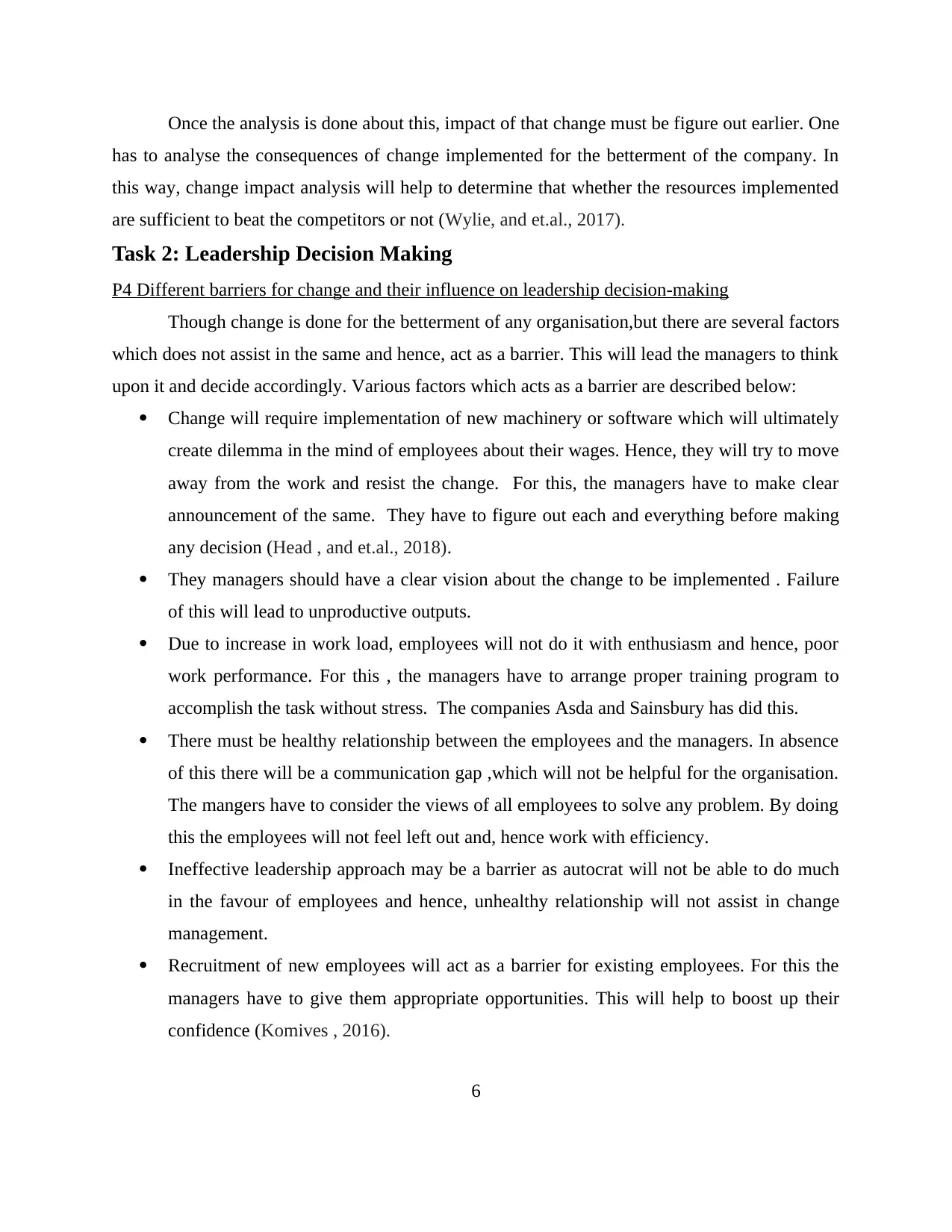
Once the analysis is done about this, impact of that change must be figure out earlier. One
has to analyse the consequences of change implemented for the betterment of the company. In
this way, change impact analysis will help to determine that whether the resources implemented
are sufficient to beat the competitors or not (Wylie, and et.al., 2017).
Task 2: Leadership Decision Making
P4 Different barriers for change and their influence on leadership decision-making
Though change is done for the betterment of any organisation,but there are several factors
which does not assist in the same and hence, act as a barrier. This will lead the managers to think
upon it and decide accordingly. Various factors which acts as a barrier are described below:
Change will require implementation of new machinery or software which will ultimately
create dilemma in the mind of employees about their wages. Hence, they will try to move
away from the work and resist the change. For this, the managers have to make clear
announcement of the same. They have to figure out each and everything before making
any decision (Head , and et.al., 2018).
They managers should have a clear vision about the change to be implemented . Failure
of this will lead to unproductive outputs.
Due to increase in work load, employees will not do it with enthusiasm and hence, poor
work performance. For this , the managers have to arrange proper training program to
accomplish the task without stress. The companies Asda and Sainsbury has did this.
There must be healthy relationship between the employees and the managers. In absence
of this there will be a communication gap ,which will not be helpful for the organisation.
The mangers have to consider the views of all employees to solve any problem. By doing
this the employees will not feel left out and, hence work with efficiency.
Ineffective leadership approach may be a barrier as autocrat will not be able to do much
in the favour of employees and hence, unhealthy relationship will not assist in change
management.
Recruitment of new employees will act as a barrier for existing employees. For this the
managers have to give them appropriate opportunities. This will help to boost up their
confidence (Komives , 2016).
6
has to analyse the consequences of change implemented for the betterment of the company. In
this way, change impact analysis will help to determine that whether the resources implemented
are sufficient to beat the competitors or not (Wylie, and et.al., 2017).
Task 2: Leadership Decision Making
P4 Different barriers for change and their influence on leadership decision-making
Though change is done for the betterment of any organisation,but there are several factors
which does not assist in the same and hence, act as a barrier. This will lead the managers to think
upon it and decide accordingly. Various factors which acts as a barrier are described below:
Change will require implementation of new machinery or software which will ultimately
create dilemma in the mind of employees about their wages. Hence, they will try to move
away from the work and resist the change. For this, the managers have to make clear
announcement of the same. They have to figure out each and everything before making
any decision (Head , and et.al., 2018).
They managers should have a clear vision about the change to be implemented . Failure
of this will lead to unproductive outputs.
Due to increase in work load, employees will not do it with enthusiasm and hence, poor
work performance. For this , the managers have to arrange proper training program to
accomplish the task without stress. The companies Asda and Sainsbury has did this.
There must be healthy relationship between the employees and the managers. In absence
of this there will be a communication gap ,which will not be helpful for the organisation.
The mangers have to consider the views of all employees to solve any problem. By doing
this the employees will not feel left out and, hence work with efficiency.
Ineffective leadership approach may be a barrier as autocrat will not be able to do much
in the favour of employees and hence, unhealthy relationship will not assist in change
management.
Recruitment of new employees will act as a barrier for existing employees. For this the
managers have to give them appropriate opportunities. This will help to boost up their
confidence (Komives , 2016).
6
Paraphrase This Document
Need a fresh take? Get an instant paraphrase of this document with our AI Paraphraser
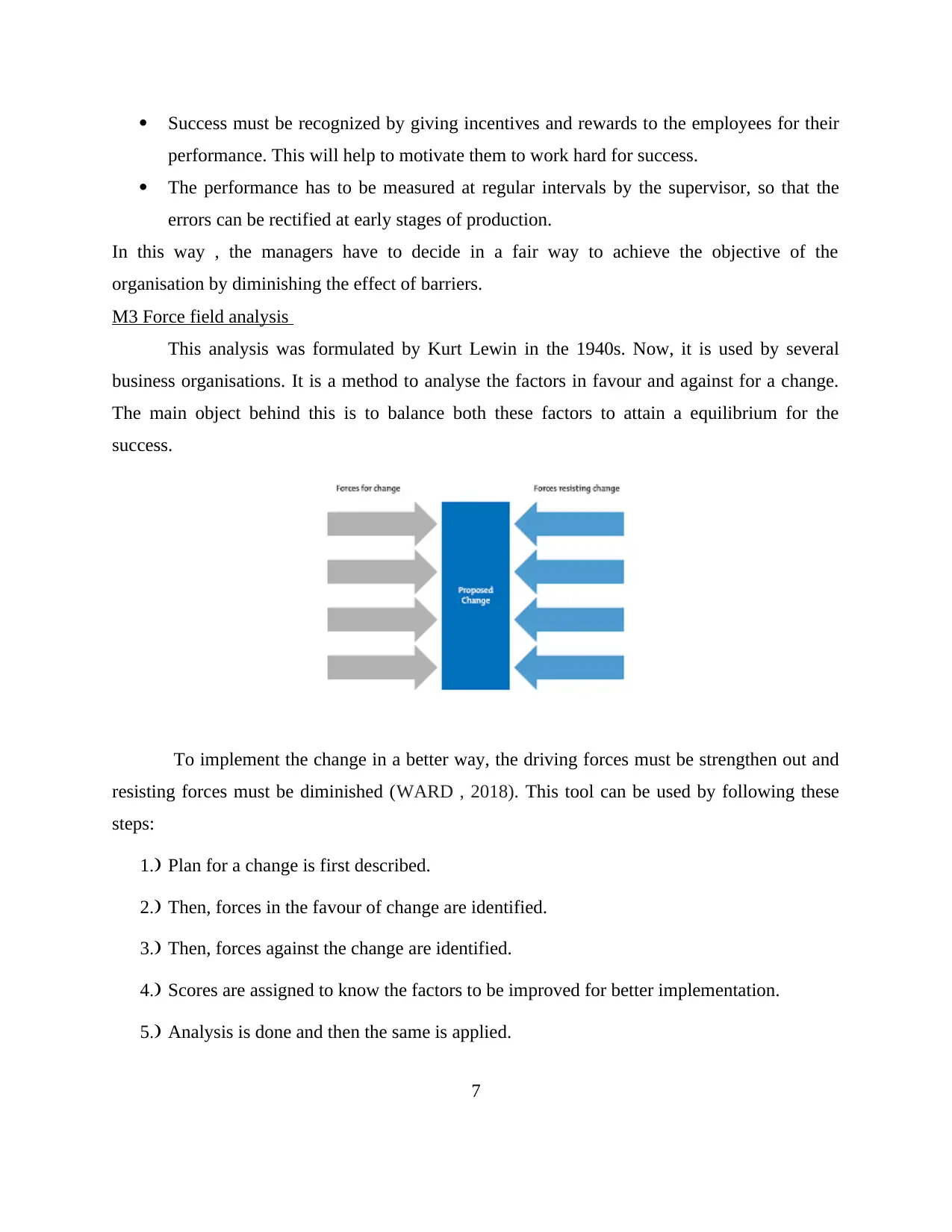
Success must be recognized by giving incentives and rewards to the employees for their
performance. This will help to motivate them to work hard for success.
The performance has to be measured at regular intervals by the supervisor, so that the
errors can be rectified at early stages of production.
In this way , the managers have to decide in a fair way to achieve the objective of the
organisation by diminishing the effect of barriers.
M3 Force field analysis
This analysis was formulated by Kurt Lewin in the 1940s. Now, it is used by several
business organisations. It is a method to analyse the factors in favour and against for a change.
The main object behind this is to balance both these factors to attain a equilibrium for the
success.
To implement the change in a better way, the driving forces must be strengthen out and
resisting forces must be diminished (WARD , 2018). This tool can be used by following these
steps:
1.) Plan for a change is first described.
2.) Then, forces in the favour of change are identified.
3.) Then, forces against the change are identified.
4.) Scores are assigned to know the factors to be improved for better implementation.
5.) Analysis is done and then the same is applied.
7
performance. This will help to motivate them to work hard for success.
The performance has to be measured at regular intervals by the supervisor, so that the
errors can be rectified at early stages of production.
In this way , the managers have to decide in a fair way to achieve the objective of the
organisation by diminishing the effect of barriers.
M3 Force field analysis
This analysis was formulated by Kurt Lewin in the 1940s. Now, it is used by several
business organisations. It is a method to analyse the factors in favour and against for a change.
The main object behind this is to balance both these factors to attain a equilibrium for the
success.
To implement the change in a better way, the driving forces must be strengthen out and
resisting forces must be diminished (WARD , 2018). This tool can be used by following these
steps:
1.) Plan for a change is first described.
2.) Then, forces in the favour of change are identified.
3.) Then, forces against the change are identified.
4.) Scores are assigned to know the factors to be improved for better implementation.
5.) Analysis is done and then the same is applied.
7
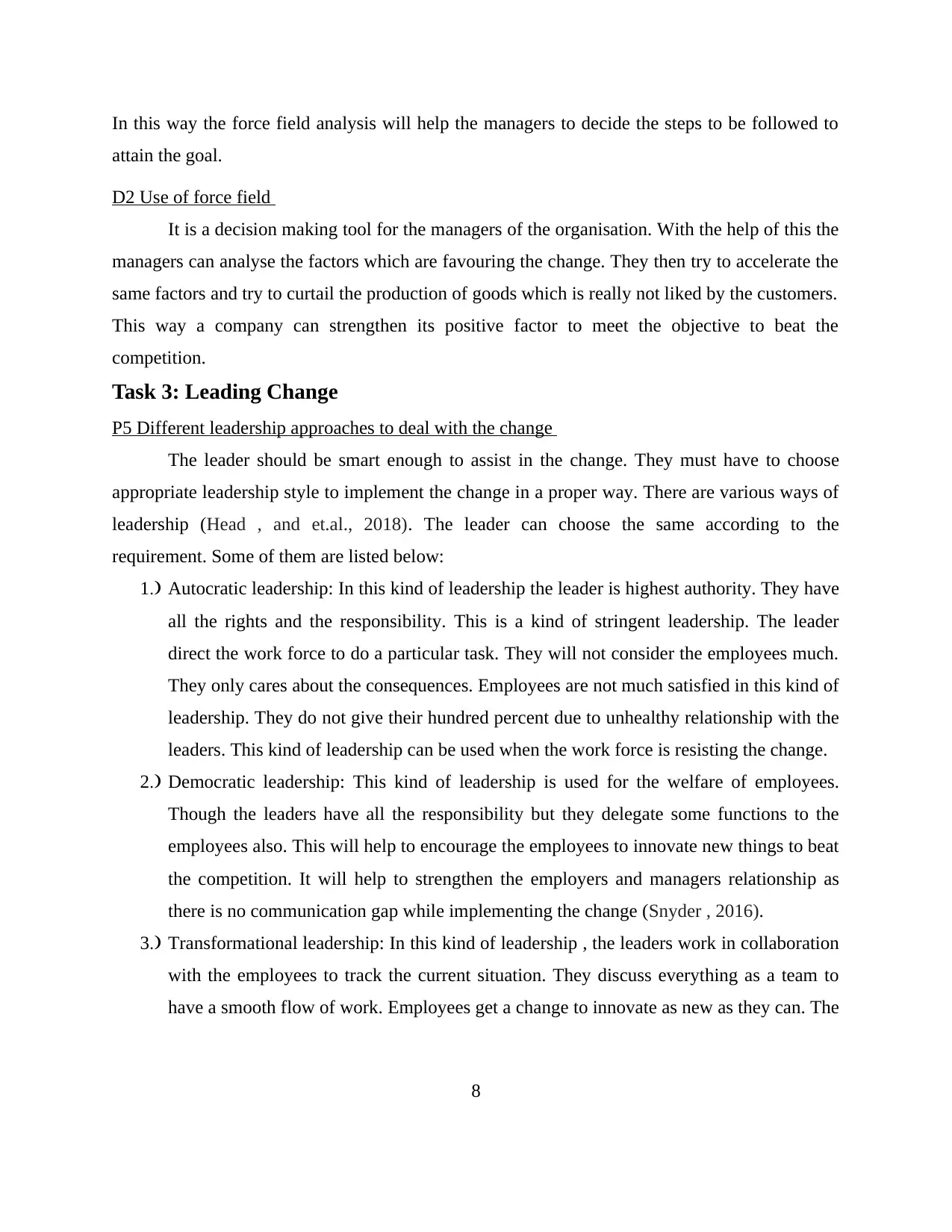
In this way the force field analysis will help the managers to decide the steps to be followed to
attain the goal.
D2 Use of force field
It is a decision making tool for the managers of the organisation. With the help of this the
managers can analyse the factors which are favouring the change. They then try to accelerate the
same factors and try to curtail the production of goods which is really not liked by the customers.
This way a company can strengthen its positive factor to meet the objective to beat the
competition.
Task 3: Leading Change
P5 Different leadership approaches to deal with the change
The leader should be smart enough to assist in the change. They must have to choose
appropriate leadership style to implement the change in a proper way. There are various ways of
leadership (Head , and et.al., 2018). The leader can choose the same according to the
requirement. Some of them are listed below:
1.) Autocratic leadership: In this kind of leadership the leader is highest authority. They have
all the rights and the responsibility. This is a kind of stringent leadership. The leader
direct the work force to do a particular task. They will not consider the employees much.
They only cares about the consequences. Employees are not much satisfied in this kind of
leadership. They do not give their hundred percent due to unhealthy relationship with the
leaders. This kind of leadership can be used when the work force is resisting the change.
2.) Democratic leadership: This kind of leadership is used for the welfare of employees.
Though the leaders have all the responsibility but they delegate some functions to the
employees also. This will help to encourage the employees to innovate new things to beat
the competition. It will help to strengthen the employers and managers relationship as
there is no communication gap while implementing the change (Snyder , 2016).
3.) Transformational leadership: In this kind of leadership , the leaders work in collaboration
with the employees to track the current situation. They discuss everything as a team to
have a smooth flow of work. Employees get a change to innovate as new as they can. The
8
attain the goal.
D2 Use of force field
It is a decision making tool for the managers of the organisation. With the help of this the
managers can analyse the factors which are favouring the change. They then try to accelerate the
same factors and try to curtail the production of goods which is really not liked by the customers.
This way a company can strengthen its positive factor to meet the objective to beat the
competition.
Task 3: Leading Change
P5 Different leadership approaches to deal with the change
The leader should be smart enough to assist in the change. They must have to choose
appropriate leadership style to implement the change in a proper way. There are various ways of
leadership (Head , and et.al., 2018). The leader can choose the same according to the
requirement. Some of them are listed below:
1.) Autocratic leadership: In this kind of leadership the leader is highest authority. They have
all the rights and the responsibility. This is a kind of stringent leadership. The leader
direct the work force to do a particular task. They will not consider the employees much.
They only cares about the consequences. Employees are not much satisfied in this kind of
leadership. They do not give their hundred percent due to unhealthy relationship with the
leaders. This kind of leadership can be used when the work force is resisting the change.
2.) Democratic leadership: This kind of leadership is used for the welfare of employees.
Though the leaders have all the responsibility but they delegate some functions to the
employees also. This will help to encourage the employees to innovate new things to beat
the competition. It will help to strengthen the employers and managers relationship as
there is no communication gap while implementing the change (Snyder , 2016).
3.) Transformational leadership: In this kind of leadership , the leaders work in collaboration
with the employees to track the current situation. They discuss everything as a team to
have a smooth flow of work. Employees get a change to innovate as new as they can. The
8
⊘ This is a preview!⊘
Do you want full access?
Subscribe today to unlock all pages.

Trusted by 1+ million students worldwide
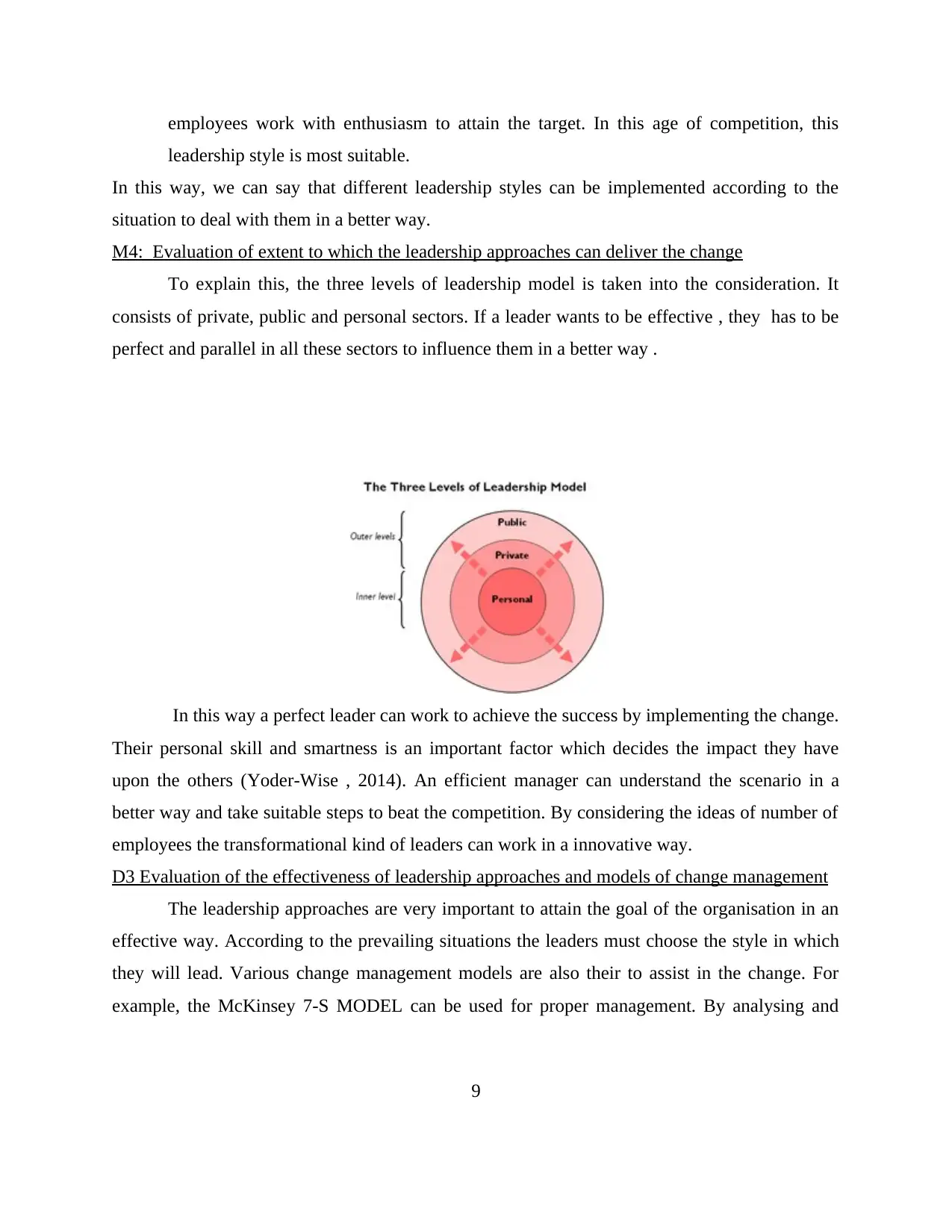
employees work with enthusiasm to attain the target. In this age of competition, this
leadership style is most suitable.
In this way, we can say that different leadership styles can be implemented according to the
situation to deal with them in a better way.
M4: Evaluation of extent to which the leadership approaches can deliver the change
To explain this, the three levels of leadership model is taken into the consideration. It
consists of private, public and personal sectors. If a leader wants to be effective , they has to be
perfect and parallel in all these sectors to influence them in a better way .
In this way a perfect leader can work to achieve the success by implementing the change.
Their personal skill and smartness is an important factor which decides the impact they have
upon the others (Yoder-Wise , 2014). An efficient manager can understand the scenario in a
better way and take suitable steps to beat the competition. By considering the ideas of number of
employees the transformational kind of leaders can work in a innovative way.
D3 Evaluation of the effectiveness of leadership approaches and models of change management
The leadership approaches are very important to attain the goal of the organisation in an
effective way. According to the prevailing situations the leaders must choose the style in which
they will lead. Various change management models are also their to assist in the change. For
example, the McKinsey 7-S MODEL can be used for proper management. By analysing and
9
leadership style is most suitable.
In this way, we can say that different leadership styles can be implemented according to the
situation to deal with them in a better way.
M4: Evaluation of extent to which the leadership approaches can deliver the change
To explain this, the three levels of leadership model is taken into the consideration. It
consists of private, public and personal sectors. If a leader wants to be effective , they has to be
perfect and parallel in all these sectors to influence them in a better way .
In this way a perfect leader can work to achieve the success by implementing the change.
Their personal skill and smartness is an important factor which decides the impact they have
upon the others (Yoder-Wise , 2014). An efficient manager can understand the scenario in a
better way and take suitable steps to beat the competition. By considering the ideas of number of
employees the transformational kind of leaders can work in a innovative way.
D3 Evaluation of the effectiveness of leadership approaches and models of change management
The leadership approaches are very important to attain the goal of the organisation in an
effective way. According to the prevailing situations the leaders must choose the style in which
they will lead. Various change management models are also their to assist in the change. For
example, the McKinsey 7-S MODEL can be used for proper management. By analysing and
9
Paraphrase This Document
Need a fresh take? Get an instant paraphrase of this document with our AI Paraphraser
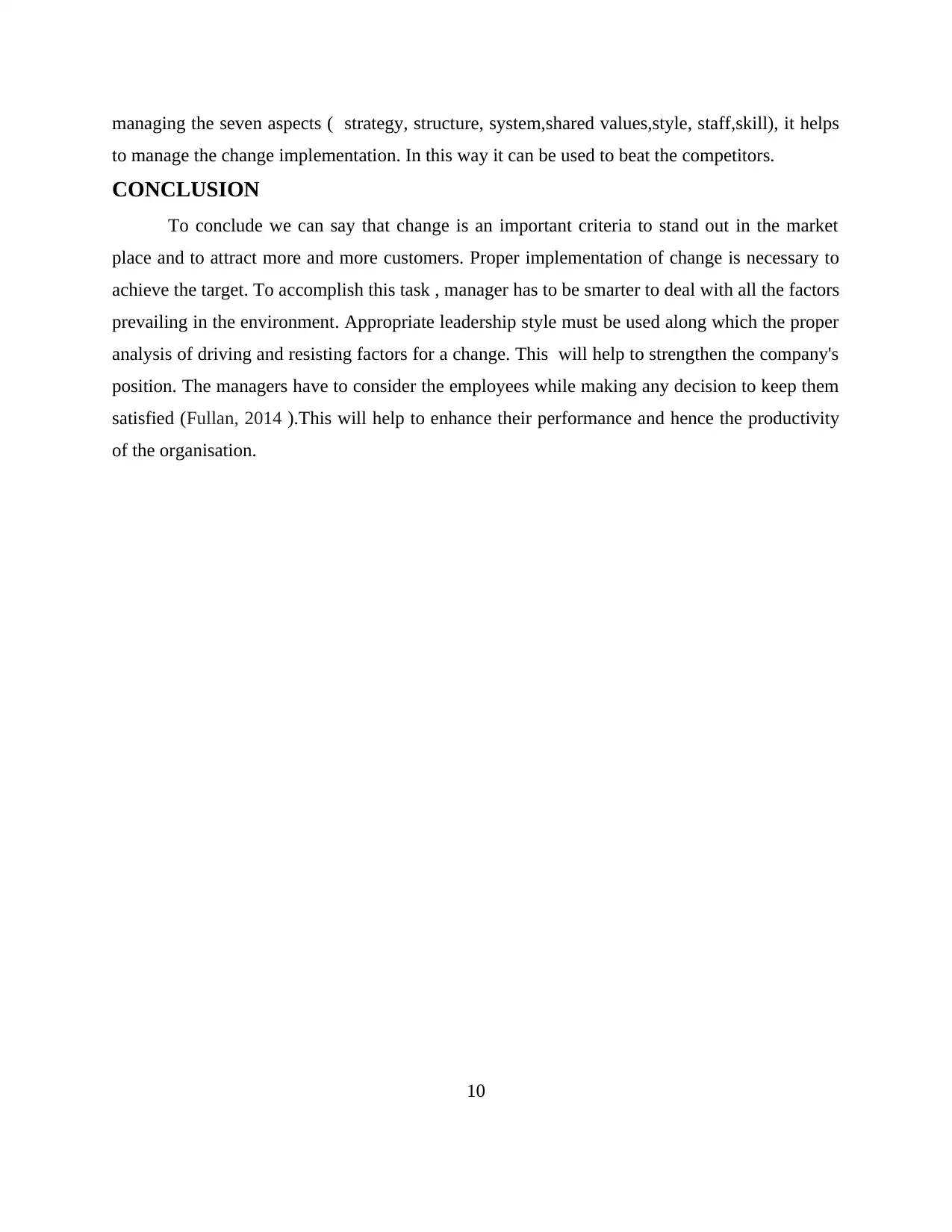
managing the seven aspects ( strategy, structure, system,shared values,style, staff,skill), it helps
to manage the change implementation. In this way it can be used to beat the competitors.
CONCLUSION
To conclude we can say that change is an important criteria to stand out in the market
place and to attract more and more customers. Proper implementation of change is necessary to
achieve the target. To accomplish this task , manager has to be smarter to deal with all the factors
prevailing in the environment. Appropriate leadership style must be used along which the proper
analysis of driving and resisting factors for a change. This will help to strengthen the company's
position. The managers have to consider the employees while making any decision to keep them
satisfied (Fullan, 2014 ).This will help to enhance their performance and hence the productivity
of the organisation.
10
to manage the change implementation. In this way it can be used to beat the competitors.
CONCLUSION
To conclude we can say that change is an important criteria to stand out in the market
place and to attract more and more customers. Proper implementation of change is necessary to
achieve the target. To accomplish this task , manager has to be smarter to deal with all the factors
prevailing in the environment. Appropriate leadership style must be used along which the proper
analysis of driving and resisting factors for a change. This will help to strengthen the company's
position. The managers have to consider the employees while making any decision to keep them
satisfied (Fullan, 2014 ).This will help to enhance their performance and hence the productivity
of the organisation.
10
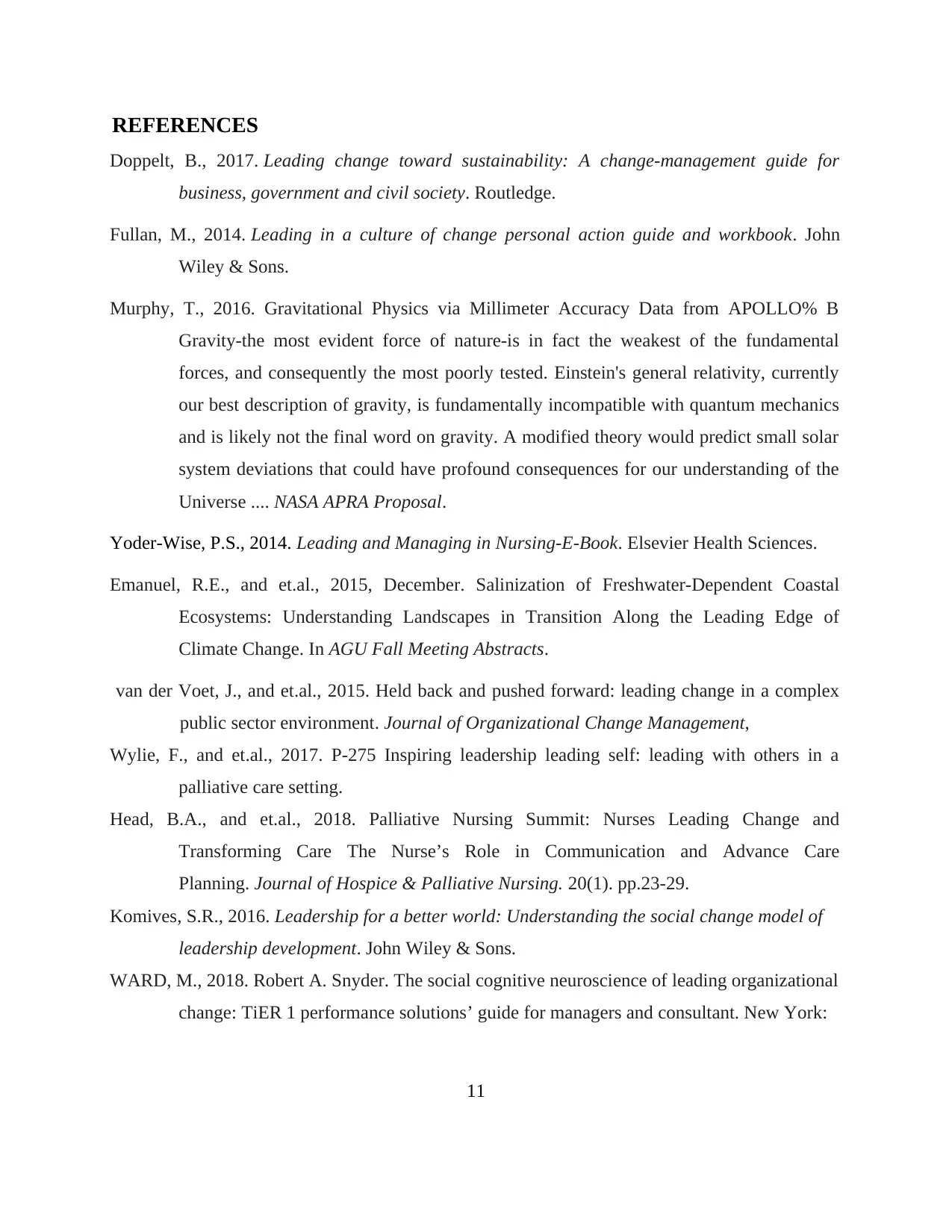
REFERENCES
Doppelt, B., 2017. Leading change toward sustainability: A change-management guide for
business, government and civil society. Routledge.
Fullan, M., 2014. Leading in a culture of change personal action guide and workbook. John
Wiley & Sons.
Murphy, T., 2016. Gravitational Physics via Millimeter Accuracy Data from APOLLO% B
Gravity-the most evident force of nature-is in fact the weakest of the fundamental
forces, and consequently the most poorly tested. Einstein's general relativity, currently
our best description of gravity, is fundamentally incompatible with quantum mechanics
and is likely not the final word on gravity. A modified theory would predict small solar
system deviations that could have profound consequences for our understanding of the
Universe .... NASA APRA Proposal.
Yoder-Wise, P.S., 2014. Leading and Managing in Nursing-E-Book. Elsevier Health Sciences.
Emanuel, R.E., and et.al., 2015, December. Salinization of Freshwater-Dependent Coastal
Ecosystems: Understanding Landscapes in Transition Along the Leading Edge of
Climate Change. In AGU Fall Meeting Abstracts.
van der Voet, J., and et.al., 2015. Held back and pushed forward: leading change in a complex
public sector environment. Journal of Organizational Change Management,
Wylie, F., and et.al., 2017. P-275 Inspiring leadership leading self: leading with others in a
palliative care setting.
Head, B.A., and et.al., 2018. Palliative Nursing Summit: Nurses Leading Change and
Transforming Care The Nurse’s Role in Communication and Advance Care
Planning. Journal of Hospice & Palliative Nursing. 20(1). pp.23-29.
Komives, S.R., 2016. Leadership for a better world: Understanding the social change model of
leadership development. John Wiley & Sons.
WARD, M., 2018. Robert A. Snyder. The social cognitive neuroscience of leading organizational
change: TiER 1 performance solutions’ guide for managers and consultant. New York:
11
Doppelt, B., 2017. Leading change toward sustainability: A change-management guide for
business, government and civil society. Routledge.
Fullan, M., 2014. Leading in a culture of change personal action guide and workbook. John
Wiley & Sons.
Murphy, T., 2016. Gravitational Physics via Millimeter Accuracy Data from APOLLO% B
Gravity-the most evident force of nature-is in fact the weakest of the fundamental
forces, and consequently the most poorly tested. Einstein's general relativity, currently
our best description of gravity, is fundamentally incompatible with quantum mechanics
and is likely not the final word on gravity. A modified theory would predict small solar
system deviations that could have profound consequences for our understanding of the
Universe .... NASA APRA Proposal.
Yoder-Wise, P.S., 2014. Leading and Managing in Nursing-E-Book. Elsevier Health Sciences.
Emanuel, R.E., and et.al., 2015, December. Salinization of Freshwater-Dependent Coastal
Ecosystems: Understanding Landscapes in Transition Along the Leading Edge of
Climate Change. In AGU Fall Meeting Abstracts.
van der Voet, J., and et.al., 2015. Held back and pushed forward: leading change in a complex
public sector environment. Journal of Organizational Change Management,
Wylie, F., and et.al., 2017. P-275 Inspiring leadership leading self: leading with others in a
palliative care setting.
Head, B.A., and et.al., 2018. Palliative Nursing Summit: Nurses Leading Change and
Transforming Care The Nurse’s Role in Communication and Advance Care
Planning. Journal of Hospice & Palliative Nursing. 20(1). pp.23-29.
Komives, S.R., 2016. Leadership for a better world: Understanding the social change model of
leadership development. John Wiley & Sons.
WARD, M., 2018. Robert A. Snyder. The social cognitive neuroscience of leading organizational
change: TiER 1 performance solutions’ guide for managers and consultant. New York:
11
⊘ This is a preview!⊘
Do you want full access?
Subscribe today to unlock all pages.

Trusted by 1+ million students worldwide
1 out of 13
Related Documents
Your All-in-One AI-Powered Toolkit for Academic Success.
+13062052269
info@desklib.com
Available 24*7 on WhatsApp / Email
![[object Object]](/_next/static/media/star-bottom.7253800d.svg)
Unlock your academic potential
Copyright © 2020–2025 A2Z Services. All Rights Reserved. Developed and managed by ZUCOL.




